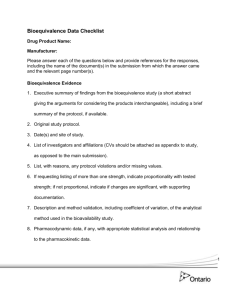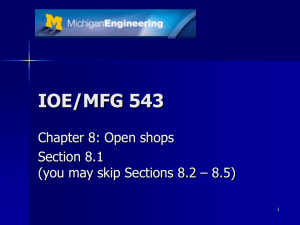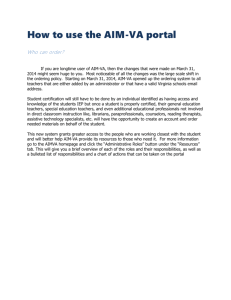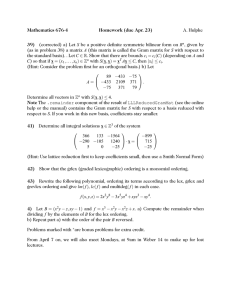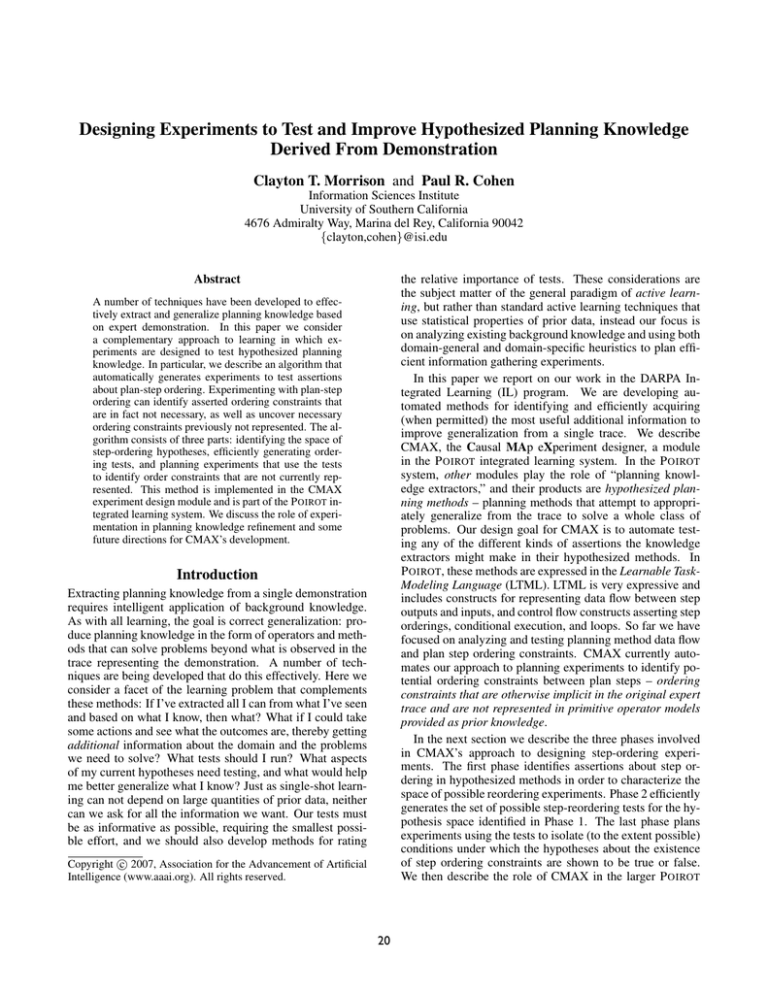
Designing Experiments to Test and Improve Hypothesized Planning Knowledge
Derived From Demonstration
Clayton T. Morrison and Paul R. Cohen
Information Sciences Institute
University of Southern California
4676 Admiralty Way, Marina del Rey, California 90042
{clayton,cohen}@isi.edu
Abstract
the relative importance of tests. These considerations are
the subject matter of the general paradigm of active learning, but rather than standard active learning techniques that
use statistical properties of prior data, instead our focus is
on analyzing existing background knowledge and using both
domain-general and domain-specific heuristics to plan efficient information gathering experiments.
In this paper we report on our work in the DARPA Integrated Learning (IL) program. We are developing automated methods for identifying and efficiently acquiring
(when permitted) the most useful additional information to
improve generalization from a single trace. We describe
CMAX, the Causal MAp eXperiment designer, a module
in the P OIROT integrated learning system. In the P OIROT
system, other modules play the role of “planning knowledge extractors,” and their products are hypothesized planning methods – planning methods that attempt to appropriately generalize from the trace to solve a whole class of
problems. Our design goal for CMAX is to automate testing any of the different kinds of assertions the knowledge
extractors might make in their hypothesized methods. In
P OIROT, these methods are expressed in the Learnable TaskModeling Language (LTML). LTML is very expressive and
includes constructs for representing data flow between step
outputs and inputs, and control flow constructs asserting step
orderings, conditional execution, and loops. So far we have
focused on analyzing and testing planning method data flow
and plan step ordering constraints. CMAX currently automates our approach to planning experiments to identify potential ordering constraints between plan steps – ordering
constraints that are otherwise implicit in the original expert
trace and are not represented in primitive operator models
provided as prior knowledge.
In the next section we describe the three phases involved
in CMAX’s approach to designing step-ordering experiments. The first phase identifies assertions about step ordering in hypothesized methods in order to characterize the
space of possible reordering experiments. Phase 2 efficiently
generates the set of possible step-reordering tests for the hypothesis space identified in Phase 1. The last phase plans
experiments using the tests to isolate (to the extent possible)
conditions under which the hypotheses about the existence
of step ordering constraints are shown to be true or false.
We then describe the role of CMAX in the larger P OIROT
A number of techniques have been developed to effectively extract and generalize planning knowledge based
on expert demonstration. In this paper we consider
a complementary approach to learning in which experiments are designed to test hypothesized planning
knowledge. In particular, we describe an algorithm that
automatically generates experiments to test assertions
about plan-step ordering. Experimenting with plan-step
ordering can identify asserted ordering constraints that
are in fact not necessary, as well as uncover necessary
ordering constraints previously not represented. The algorithm consists of three parts: identifying the space of
step-ordering hypotheses, efficiently generating ordering tests, and planning experiments that use the tests
to identify order constraints that are not currently represented. This method is implemented in the CMAX
experiment design module and is part of the P OIROT integrated learning system. We discuss the role of experimentation in planning knowledge refinement and some
future directions for CMAX’s development.
Introduction
Extracting planning knowledge from a single demonstration
requires intelligent application of background knowledge.
As with all learning, the goal is correct generalization: produce planning knowledge in the form of operators and methods that can solve problems beyond what is observed in the
trace representing the demonstration. A number of techniques are being developed that do this effectively. Here we
consider a facet of the learning problem that complements
these methods: If I’ve extracted all I can from what I’ve seen
and based on what I know, then what? What if I could take
some actions and see what the outcomes are, thereby getting
additional information about the domain and the problems
we need to solve? What tests should I run? What aspects
of my current hypotheses need testing, and what would help
me better generalize what I know? Just as single-shot learning can not depend on large quantities of prior data, neither
can we ask for all the information we want. Our tests must
be as informative as possible, requiring the smallest possible effort, and we should also develop methods for rating
c 2007, Association for the Advancement of Artificial
Copyright Intelligence (www.aaai.org). All rights reserved.
20
integrated learning architecture, place CMAX in the context
of prior and ongoing work related to planning experiments
to improve domain knowledge, and conclude with a brief
discussion of next steps in CMAX’s development.
2. Not explicitly representing a step order constraint means
that plans may be generated that violate the constraint and
subsequently fail to successfully execute.
We can test for either of these generalization failures by producing totally-ordered workflows with different step orderings, execute them, and see whether they succeed or fail. In
the next three sections we describe the three phases involved
in generating experiments to identify missing or misrepresented ordering constraints. Throughout this discussion we
will focus on how to generate the specific subsequences of
steps that we wish to re-order. However, we assume that
these subsequences are portions of an overall “complete”
workflow whose other steps remain in the same order they
would be using the original, unmodified methods to generate
a workflow.
Generating Step-Order Experiments
In the P OIROT domain, planning knowledge is represented
as sets of planning methods expressed in the LTML task
modeling language.When presented with a planning problem (an initial world state and goal), P OIROT submits a set
of methods to a planner and an executable workflow is generated. A workflow is a totally-ordered sequence of steps1 ,
where each step may involve executing a primitive action,
and output-to-input data flow between steps is specified by
data flow links. An executive then executes the workflow
and reports the results of the execution.
There are three possible outcomes of workflow execution:
a workflow could (1) fail to execute because one of the steps
in the workflow cannot be enacted or completed; or, if execution completes, the executive determines whether the executed workflow has (2) failed or (3) succeeded in satisfying
the planning goal. If the execution fails (with either outcome
1 or 2), then we conclude that one or more planning method
constructs in incorrect. If, on the other hand, a workflow
execution succeeds in satisfying the planning problem goal
(outcome 3), then we conclude that the planning knowledge
was at least sufficient for this problem instance. We define
a test to be the execution of a workflow – a workflow that
is “complete” in the sense that it is intended to completely
satisfy the planning goal.2 (From here on, unless otherwise
noted, we will use the terms “test” and “workflow” interchangeably.) An experiment, then, consists of the execution
of one or more workflows. Our goal for CMAX’s experiment design procedure is to construct workflows as experiments whose outcomes inform our beliefs about the efficacy
of our planning knowledge, as expressed in our planning
methods.
There are many different aspects of hypothesized planning knowledge that we might try to test. We have chosen
to target assertions about step ordering first because in the
IL project assertions about step order constraints are common. By step-order constraint we mean that a step order
is necessary: if step s1 is constrained to occur before step
s2 , then having s2 occur before s1 in a workflow will result
in execution failure. Misrepresenting step order constraints
results in at least one of two kinds of planning knowledge
generalization failures:
Phase 1: The Step-order Hypthesis Space
The first task for CMAX is to identify the space of step order
constraint hypotheses we wish to test. In order to describe
this hypothesis space, we review some (likely familiar) concepts about order relations. Consider a totally ordered sequence of three elements, a b c, and let ≺ represent the irreflexive, asymmetric and transitive order relation (assuming
left-to-right directionality). In the sequence, a comes before
b is represented by a ≺ b, and b comes before c is represented by b ≺ c. We also have, by transitivity, the order
relation a ≺ c. If we add one more element, d, to the rightend of a b c, then we introduce three more order relations:
a ≺ d, b ≺ d and c ≺ d. In general, for each element we
add to the right-hand end of the sequence, we introduce a set
of order relations between every prior element and the new
one. The total number of order relations present in a totally
ordered sequence of n elements is K = (n2 −n)/2. We will
refer to this complete set of order relations as the transitive
closure of order relations over the totally ordered sequence.
Without prior knowledge about order constraints, any of the
K order relations in the transitive closure over a sequence of
steps is a candidate step-order constraint.
CMAX distinguishes between two classes of order constraints expressed in LTML methods and treats them differently for purpose of step-order experimentation. The first
class consists of assertions about step ordering that range
from fully specifying step sequences (in Sequence clauses)
to leaving steps unordered (in Activity-graph clauses);
Activity-graphs may include predicate clauses whose conditions must be maintained, thus asserting some constraints.
CMAX identifies groups of steps associated with these
clauses and experiments with their order. Depending on the
experiment outcome, CMAX may recommend revising the
current method’s step order constructs.
The other class of order constraints consists of data flow
assertions. The need for data flow representation arises because the P OIROT system operates in a semantic web service
domain, where primitive actions are calls to web services
with input parameter values and possible return value outputs. LTML provides a links construct to specify how output values resulting from web service calls are used as input
values to later service calls.
1. Asserting an ordering constraint that is in fact not necessary may make later plan generation under new circumstances appear impossible when in fact a plan could be
generated if the order constraint were ignored.
1
In this phase of our work we do not consider parallel plan-step
execution.
2
We could define a test to be a shorter sequence of steps aimed
at achieving local goals. This raises a number of issues for experimentation (including reasoning about subgoals and their satisfaction) that are beyond the scope of the work we report here.
21
Figure 1: A represents the link-based order constraint relations (directed edges) identified for a sequence in a method fragment;
the pairs of step numbers in parentheses represent individual order relations; labels on the edges represent values that would be
assigned to the corresponding links were the method used to reproduce the demonstration trace as an executing workflow. B
represents a re-ordering of the step sequence that preserves the link-order constraints identified in A, but violates (and therefore
tests) eight candidate order constraints.
In the version of the step order experiment design algorithm we present here, CMAX generates orderings of steps
that preserve these links, thus treating them as order constraints that cannot be violated. In later versions of CMAX,
ordering experiments will be generated that also test dataflow links.
Figure 1 A represents data flow links as directed edges
between steps. In this example, the space of candidate order constraints that CMAX will test is the set of order relations other than the set of link order constraints. Put another
way, the target set of relations to test consists of the relations
that remain after removing the link order constraints from the
transitive closure of order relations over the total ordered sequence of steps. This target set of relations is represented
beneath Figure 1 A as the list of thirteen ordered pairs of
step numbers. Figure 1 B shows an example of a reordering
that preserves the original link orders while violating eight
of the target candidate order constraints.
to (potentially) isolate order relations between non-adjacent
steps. For example, if we first run an experiment with the
step order b a c and it succeeds, then we can eliminate a ≺ b
as a candidate order constraint. Now that we know that it
does not matter in what order a and b occur, we can use ordering (2) b c a and be certain that if it fails, it is due to
violating a ≺ c. If, however, the b a c workflow fails, then
the a ≺ b order is necessary and b c a is guaranteed to fail
irrespective of the relationship between a and c. In this case,
we must try a different sequence of tests to isolate the a ≺ c
relation. We won’t know ahead of time which sequences of
tests we will need so we must be prepared to consider any
of them. We need a general method for generating orderings
that violate different combinations of relations representing
candidate order constraints while preserving data flow link
constraints.
The naive approach to generating the desired set of sequences is to generate the complete set of permutations (with
no constraints) and then select only those that satisfy the
link order constraints. Unfortunately, for n elements there
are n! unconstrained sequences. For the seven steps in Figure 1 this involves generating 7! = 5040 sequences. We can
greatly reduce our work by generating only those permutations that satisfy the link order constraints.3 For the seven
steps in Fig. 1, there are actually only 144 permutations that
Phase 2: Efficiently Generating Tests
If we could test each candidate order constraint individually, then in the example we would only need thirteen tests:
for each order relation, simply swap the two elements in the
relation, thereby violating any underlying order constraint,
and see if the workflow successfully executes. However, this
is only possible for order relations between adjacent steps.
For example, for the a b c sequence we have three options
for testing the necessity of the a ≺ c order: (1) c a b, which
violates a ≺ c and b ≺ c; (2) b c a, which violates a ≺ c
and a ≺ b; and (3) c b a, which violates all three original
order relations. In no case can we violate only a ≺ c. As
we will see in the next section, we may combine tests so as
3
While there is no known formula for calculating the number of permutations that preserve arbitrary ordering constraints
(Brightwell & Winkler 1991), we do know that if the longest chain
of ordering constraints includes c elements (e.g., steps 2, 4 and 5 in
Figure 1 A form a chain of length 3), then the number of permutations is upper bounded by n!/c!.
22
and wl does not violate yr ≺ wl , and neither does it violate yr ≺ x and x ≺ wl .
The final extension to the distribution operation involves
handling the case where we add two new elements, p and q,
to the sequence while also maintaining p ≺ q. In the base
case, where neither p nor q have constraints with any of the
elements already in the sequence, we distribute them as follows. Round 1: starting at the left-most end of the sequence,
insert p, then distribute q over the positions around the elements to the right of p, including the position between p and
the elements to the right. Round 2: starting with the original
sequence (in the state before we inserted p and q), this time
insert p to the first free position directly the right of the position we inserted it in round 1; this means the first element
in the original sequence is to the left of p. Again distribute
q, but this time over the remaining elements to the right of
p. And we keep doing this: for the i + 1th step, apply the
procedure, each time starting with p in the next position to
the right of its starting position in the ith , until p is finally
placed in the right-most position of the original sequence
and q is placed to the right of p. This completely distributes
p and q while maintaining p ≺ q in each generated sequence.
What about cases where either p or q have different ordering constraints with elements already in the sequence? We
could enumerate each possibility in a separate case, but we
don’t actually need to because we only end up needing the
base case of the two-element distribution operation while
constructing our set of order-constraint-preserving permutations. We now present the complete permutation generation
algorithm.
The first step in the algorithm is to generate all of the permutations of elements involved in just the link-order constraints. (This can involve all of the elements in the original
sequence; we deal with any remaining elements below). We
do this by incrementally adding each ordered pair of steps
in the list of ordering constraints to the accruing set of permutations. Using the example in Figure 1 A, we start with
2 ≺ 3. Next we distribute 2 ≺ 4. Since 2 is already in the
sequence, we simply distribute the single element 4 over the
position(s) to the right of 2. Next we distribute 8 following
the 2 ≺ 8 constraint, and so on.
We run into trouble, however, when we add 6 ≺ 7. Since
neither step is constrained by steps already in the sequences,
we use the two-element base-case distribution operation.
While there’s nothing wrong with the two-element distribution method itself, there is a problem with having distributed
6 ≺ 7 this early. By doing so, one of the sequences generated is (2 3 4 5 8 6 7). In the next step, we then try to add
6 ≺ 8, which we now see constrains 6 to only occur before 8.
To avoid this kind of problem, we ensure the following does
not happen: when adding x ≺ y and neither x nor y appears
already in the sequence, test whether there is another, yet-tobe-added order constraint such that one of its elements is x
or y and the other element already appears in the sequence.
If so, do not add x ≺ y yet; push it to the end of the list of
to-be-added constraints and select another order constraint,
again testing for this condition. What this ensures is that we
don’t completely distribute two new steps thereby violating
a constraint that will be added later.
satisfy all of the identified link order constraints – an order
of magnitude fewer than the full set of unconstrained permutations. The following algorithm generates all, and only,
the permutations satisfying the set of (consistent) ordering
constraints.
First, consider a single order constraint a ≺ b. All this
relation asserts is that a has to come before b. If element c
has no order constraints involving a and b, then we are free
to place c in any region (indicated by ‘ ’) around a and b:
a b . Doing so does does nothing to the original a ≺ b
order relation. We say that we distribute c over the sequence
a b if we generate a new sequence for each placement of
c. Distributing c over a and b thus produces: c a b, a c b,
and a b c. We can repeat this operation, distributing a new
unconstrained element d over the four positions around each
of the three new sequences that include a, b and c.
The operation above distributes elements that have no
order constraints with elements already in the sequences.
There are three cases to consider when distributing an element that does have order constraints involving one or more
elements in the sequence:
• Case 1: Suppose we add element x so a sequence containing elements of types y and z. If x only has order
constraints with the y’s, such that for every y: yi ≺ x,
but no constraints with the z’s, then x can be distributed
over any of the positions to the right of the right-most y.
Note that if there are no z’s to the right of the right-most
y, then distributing x results in only one new sequence:
the original sequence with x appended to the right-end.
• Case 2: This is the converse of case 1; suppose instead
that for every y: x ≺ yi . Now x can only be distributed
over any of the positions to the left of the left-most y.
• Case 3: Now suppose there are three types of elements y,
w and z. Again, x has no order constraints with the z’s.
If x is constrained with y’s and w’s such that for every
y: yi ≺ x and for every w: x ≺ wj , then x can only be
distributed over positions between the right-most y and
the left-most w.
For Cases 1 and 2 we noted that x has at least one position it can occupy – at one end of the original sequence –
while not violating it’s existing order constraints with the
y’s. This is important because while we are presenting the
distributing operation as a constructive method of generating sequences that result from adding elements, what we are
eventually producing is a set of permutations where every resulting permutation involves all of the individual elements.
We therefore need to make sure Case 3 does not preclude x
from appearing somewhere if x is a member of any of the
other sequences. To show this, we make the following two
observations:
1. If x is in the original set of elements and has the constraints that for all y: yi ≺ x and for all w: x ≺ wj , then
for all y and w: yi ≺ wj . This follows from transitivity
the of the ≺ relation: yi ≺ x ≺ wj .
2. Given observation 1, it follows that there must be at least
one position for x between the right-most yr and the leftmost wl because simply placing and element between yr
23
ers. We also pointed out that we can combine tests to isolate
individual order constraints. In Figure 2 we show how test
sequences are related. In this example, a simple 4-step sequence has one link constraint (pictured at the top of the figure). Below the sequence is the list of order relations representing the candidate order constraints we wish to test. Each
node in the graph at the center of the figure represents a permuted sequence. Below each sequence is a binary vector
representing which candidate order constraints are violated
by the sequence – a 1 indicates a violation and the positions
correspond to the positions of the candidate order constraints
in the list above the graph. For example, sequence (0 1 3
2) violates the fifth candidate order constraint 2 ≺ 3. The
nodes are arranged into rows such that all nodes in a row violate the same number of order relations; the numbers in the
left margin indicate how many. Finally, the directed arrows
represent that the sequence the arrow is pointing toward violates the order relations of the sequence at the tail of the
arrow as well as others – that is, the parent violations are
a subset of the child violations. (These subset relationships
are transitive, but for clarity, transitive edges have been removed.) For example, (1 0 3 2) and (0 1 3 2) both violate
2 ≺ 3, but (1 0 3 2) also violates 0 ≺ 1. The subset relationships, as represented by the arrows, are not the only kind of
relation between the sequences. Sets of violated order relations for two nodes may also partially overlap. Again, for
clarity these edges are not pictured. We refer to this graph
as a test dependency graph (TDG).
The TDG is a useful representation for selecting tests for
an experiment. After a sequence is executed, we update the
graph based on the execution outcome. For example, if we
execute sequence (0 1 3 2) and it succeeds, then we now
know that relation 2 ≺ 3 is not necessary. This also means
that any other tests violating this relation will not fail because of this violation – if another test fails it is due to some
other constraint. In this example, we update the TDG by removing all 1’s in index 5 of the binary vector (representing
2 ≺ 3). After the update, sequence (1 0 3 2) has only one remaining candidate order constraint, 0 ≺ 1. Running the test
(1 0 3 2) will now determine with certainty whether 0 ≺ 1 is
necessary. Test success may also lead to the removal of other
tests: any ancestor (according to the subset relation depicted
by the arrows) may be removed from the graph because all
violated order relations of the ancestors have been shown to
be not necessary, so running their test won’t tell us anything
new.
Updating due to test failure works in a complementary
fashion. If a test fails, then we know that any descendant
according to the subset relation will also fail, since descendants always violate more order relations. Again, we remove
these because they can no longer tell us anything new.4 Any
Figure 2: Test Dependency Graph
After generating all of the permutations involving the ordering constraints, any remaining steps, by definition, have
no constraints with any of the steps in the sequences. We
distribute them, one at a time, over the set of sequences.
This algorithm generates all of the permutations that satisfy the link-order constraints, and no more. In the worst
case, when there are no order-constraints, the algorithm runs
in O(n!) (both in time and for the space required to store the
generated sequences for the next phase). As long as there
are a significant number of order constraints, time and space
is much better.
Phase 3: Planning Effective Experiments
We now refine our definition of experiments and describe
how they are constructed. Experiments are sets of tests chosen to determine whether ordering assertions made in LTML
methods are valid. In Phase 1, CMAX identifies sets of steps
(and their link constraints) involved in LTML method ordering constructs. In Phase 2, CMAX generates orderings of
these steps that can be used to test whether the ordering constructs are valid. Each experiment generated in this phase
will test only one ordering construct at a time. Recall that
while our focus has been on permuting a sequence of steps,
a full test in an experiment consists of these permutations in
the context of other steps that together form a “complete”
workflow. That is, our experiments alter, through reordering, a component of a workflow that is otherwise expected
to solve the planning problem instance. If the workflow fails
to execute, the cause is somewhere in the alteration.
In the previous section we noted that some sequences will
test more than one order constraint at the same time, and
some order relations cannot be altered without altering oth-
4
Note that when we remove tests from the graph some order relations that were not directly tested may be no longer represented
in the graph. This is due to transitivity. In the example, suppose
we find that 0 ≺ 1 is necessary. Since 1 ≺ 3 is already a link constraint, 0 ≺ 3 must also be necessary, by transitivity. We see this
in the TDG update: when (1 0 2 3) fails (0 ≺ 1 is necessary), we
remove all descendants, including everything with a 1 at position 3
in the binary vector: (1 2 3 0), (1 3 2 0) and (2 1 3 0).
24
CMAX as a Module in a Learning System
Figure 3 provides a schematic diagram of the protocol for interacting with CMAX as an experiment generating and testing module. Because experiment generation is an iterative
process that depends on the outcome of executed tests, there
are several phases to calling CMAX as an experiment generating service. The arrows in the figure represent data flow.
When CMAX is initially called (Step A), it is given as input
a set of primitive operators, the demonstration trace (this is
used in other processing not covered here), and a set of hypothesized methods. CMAX then goes through the phases
of method analysis, test generation and experiment construction, resulting in the output of an experiment package (Step
B). The experiment package includes a set of workflows representing the tests to be run. CMAX may identify several
different method order constructs to test and each of these
generates a separate experiment, output in a separate experiment package. In the P OIROT system, a control facility selects which experiment packages to run. When selected, the
workflows are sent to an executive and executed. Workflow
execution success or failure then sent back to CMAX for the
next phase of experiment design (Step C). In most cases, this
involves selecting the next set of tests according to the experiment generation policy, and sending a new experiment
package out. When an experiment has exhausted the relations to be tested, CMAX issues a final report describing
any changes that may need to be made to the order construct
of the method (Step D).
Figure 3: Protocol for Interacting with CMAX
other tests that overlap, however, remain tests of interest in
our search to identify which violated order relations are actual order constraints.
The overall goal in experiment test selection is to run tests
that determine which candidate order constraints are necessary. At the same time, we want to minimize the total number of tests we execute. There are several test selection policies to choose from, and which in the long run is cheaper
depends on how many actual order constraints there are. To
see this, consider binary versus linear search, two ends of
a spectrum of policies. If there are likely only a few order
constraints, binary search can be significantly cheaper than
linearly testing each individual order. In binary search, we
start by selecting a test that violates as many order relations
as possible. If it fails, choose two new tests that (ideally)
violate half as many relations and don’t overlap in the relations they violate. As long as tests fail, keep splitting and
testing. If a test succeeds, stop further testing of that set
of relations. If no order constraints exist, then we can stop
after a single test that violates all order relations succeeds.
If there is just one order constraint, then we can uniquely
identify it while confirming all the rest are not necessary
in order O(log n) experiments (for n order relations). But
as the number of order constraints increases, binary search
quickly looses its superiority. When there are many actual
ordering constraints, it is best to confirm them by testing for
them one at a time. With many ordering constraints, binary
search could result in twice as many tests. If we have background information about the number of likely tests, then we
can use that to inform which policy to use.
Conclusion
We have presented an approach to generating experiments
that test planning knowledge about step ordering constraints.
There are several directions to go in future work with
CMAX. We have just begun to characterize the test dependency graph and there may be additional structure that we
can put to work. Also, there are many other kinds of planning knowledge hypotheses that we would like to test. While
much of the step-order generating machinery can be applied
to testing data-flow link constraints, we also need to consider
how we can generate viable alternative links without rendering a method unusable. Other constructs include branching
conditions and looping constructs. In general, these extensions will require moving beyond the purely syntactic combinatorics of generate and test.
We can approximate a binary search policy by starting
with sequences at the bottom of the TGD, where the tests
violate many order relations. In subsequent iterations, we
work our way up the graph and identify pairs of tests that
together cover all of the relations being tested but split the
set of relations roughly in half. Linear search starts at the
top of the graph and works its way down.
Acknowledgments
This research was supported in part by the Defense Advanced Research Projects Agency (DARPA) Integrated
Learning program, through grant FA8650-06-C-7606, subcontract to BBN Technologies.
CMAX’s default experiment construction strategy is to
conduct a linear search. CMAX first selects tests from the
top of the TGD that violate single order relations. These are
executed and and the graph is updated. Now updated tests
may have better resolving power; these are selected in the
next round and the cycle is repeated until all of the order relations have been confirmed to be actual ordering constraints
or not necessary.
References
Brightwell, G., and Winkler, P. 1991. Counting linear extensions is #p-complete. In Proceedings of the 23rd ACM
Symposium of Theory of Computation, 175–181.
25

